Human Resource Management Report: Aldi's HRM Strategies Analysis
VerifiedAdded on 2020/07/22
|17
|5031
|42
Report
AI Summary
This report provides a comprehensive analysis of Aldi's Human Resource Management (HRM) practices. It begins with an introduction to HRM, its purpose, and functions, specifically within the context of Aldi, a leading supermarket chain. The report then delves into Task 1, examining the purpose and functions of HRM within Aldi, followed by a discussion of the strengths and weaknesses of different recruitment and selection sources, including internal, external, and third-party options. Task 2 explores the benefits of HRM to both employers and employees, highlighting aspects such as improved productivity, employee retention, and organizational culture. The report also covers the effectiveness of various HRM practices. Task 3 focuses on the importance of employee relations in decision-making and the impact of employment legislation on these decisions. The report concludes by summarizing the key findings and implications of Aldi's HRM strategies. The report emphasizes the importance of HRM in managing employees effectively to achieve organizational objectives, considering both internal and external environmental factors, and applying HRM practices within the organizational context of Aldi.
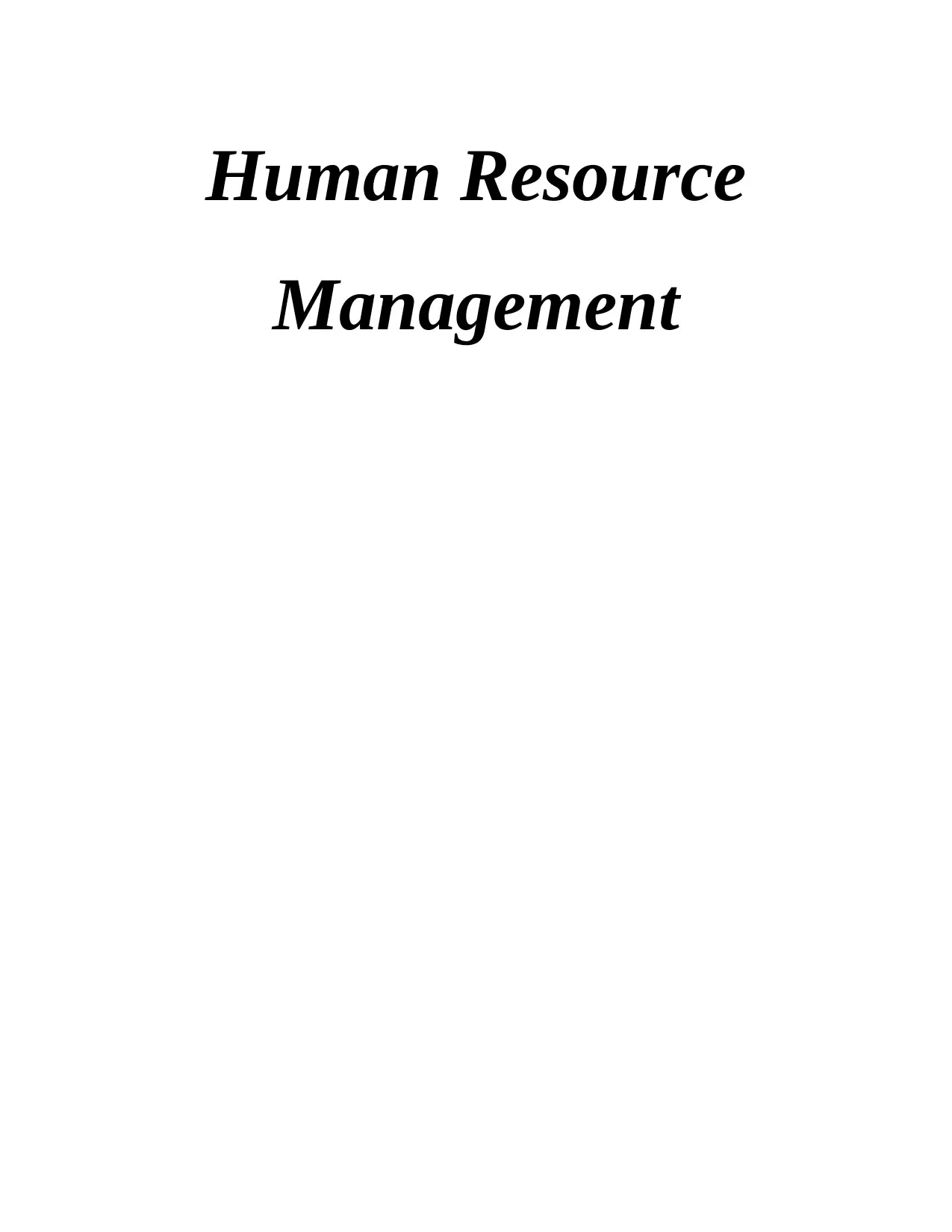
Human Resource
Management
Management
Paraphrase This Document
Need a fresh take? Get an instant paraphrase of this document with our AI Paraphraser
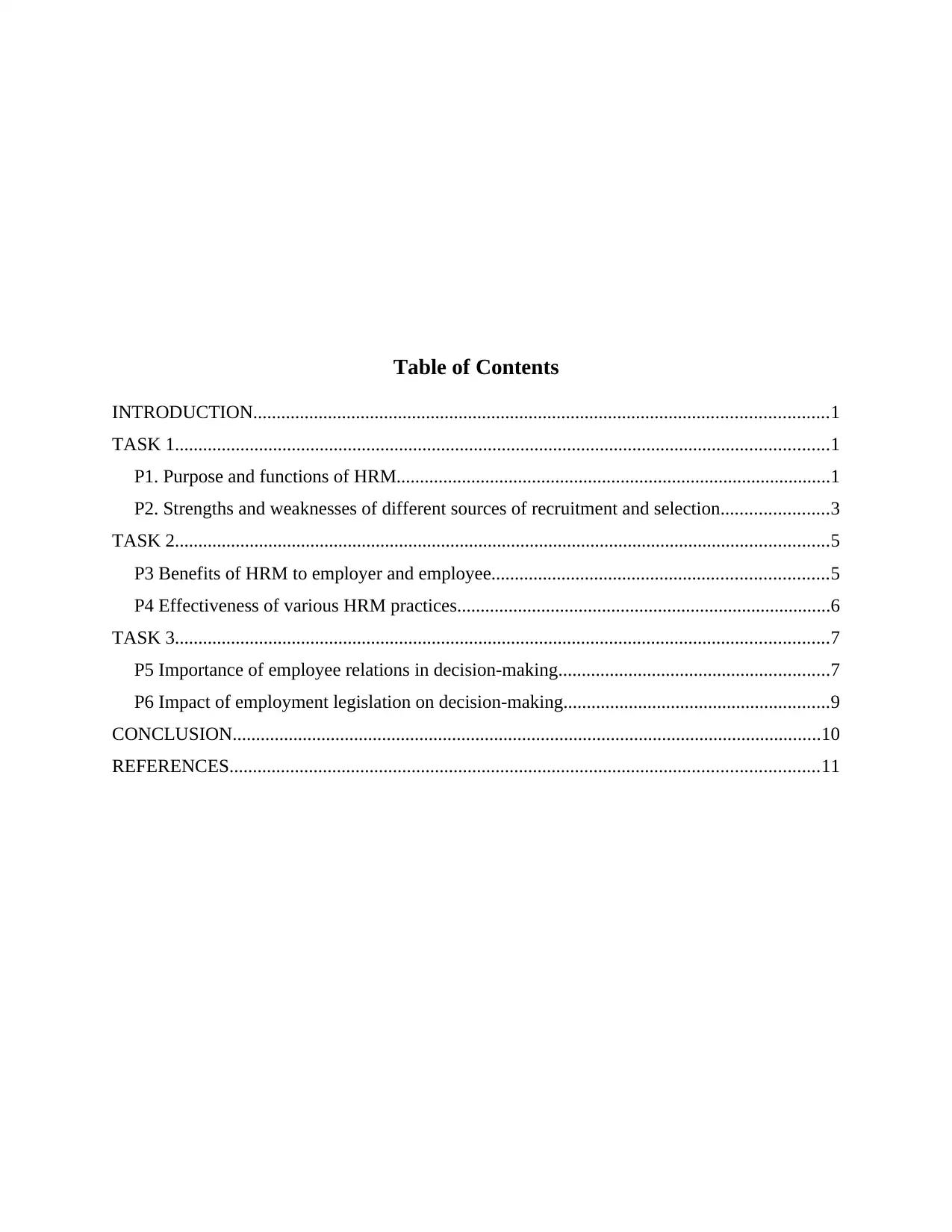
Table of Contents
INTRODUCTION...........................................................................................................................1
TASK 1............................................................................................................................................1
P1. Purpose and functions of HRM.............................................................................................1
P2. Strengths and weaknesses of different sources of recruitment and selection.......................3
TASK 2............................................................................................................................................5
P3 Benefits of HRM to employer and employee........................................................................5
P4 Effectiveness of various HRM practices................................................................................6
TASK 3............................................................................................................................................7
P5 Importance of employee relations in decision-making..........................................................7
P6 Impact of employment legislation on decision-making.........................................................9
CONCLUSION..............................................................................................................................10
REFERENCES..............................................................................................................................11
INTRODUCTION...........................................................................................................................1
TASK 1............................................................................................................................................1
P1. Purpose and functions of HRM.............................................................................................1
P2. Strengths and weaknesses of different sources of recruitment and selection.......................3
TASK 2............................................................................................................................................5
P3 Benefits of HRM to employer and employee........................................................................5
P4 Effectiveness of various HRM practices................................................................................6
TASK 3............................................................................................................................................7
P5 Importance of employee relations in decision-making..........................................................7
P6 Impact of employment legislation on decision-making.........................................................9
CONCLUSION..............................................................................................................................10
REFERENCES..............................................................................................................................11

⊘ This is a preview!⊘
Do you want full access?
Subscribe today to unlock all pages.

Trusted by 1+ million students worldwide

INTRODUCTION
Human resource management is one of the most important functions in an organisation.
This function is responsible for effective management of people in large organisation. However,
in small organisations, this function is played by the leader or entrepreneur himself. This
function encompasses the activities related to recruitment, training, development, appraisal and
lastly, compensation of employees (Barney, Ketchen and Wright, 2011). The emphasis is on
ideal utilisation of employees to achieve the objectives of organisation. Aldi is Britain's leading
supermarkets chain. This retailer was formed in the year 1913 by Karl and Theo Albrecht. This
assignment will take into consideration the practices of human resource management of this
organisation. The scope and purpose of HRM will be discussed. Also, various factors of external
and internal environment will be analysed and their impact on decision making will be
understood. Lastly, human resource management practices will be applied in organisational
context.
TASK 1
P1. Purpose and functions of HRM
ALDI have realised the workforce in respect of a company. therefore have constructed a
septate department which looks after the needs and management of people. The purpose of
creating human resource management is to make sure that human capital of an organisation is
looked after and their activities and behaviour effectually contribute in goal attainment. It
ensures that there is an effective coordination in between various human resources of
establishment. The leading functions of HRM are:
The purpose of formulating a separate department for human resources is their effective
management. It is the main reason to create a human resource department to look after
their needs and expectations to that they would remain loyal towards the organisation
(Batt and Colvin, 2011).
Another purpose of formulating human resource management is to see that employee’s
efforts and activities are contributing to the organisation goal.
Human capital of an arrangement is treated as the most important component. Therefore,
it is essential to effectively manage the same as they contribute significant amount to the
organisational objectives.
1
Human resource management is one of the most important functions in an organisation.
This function is responsible for effective management of people in large organisation. However,
in small organisations, this function is played by the leader or entrepreneur himself. This
function encompasses the activities related to recruitment, training, development, appraisal and
lastly, compensation of employees (Barney, Ketchen and Wright, 2011). The emphasis is on
ideal utilisation of employees to achieve the objectives of organisation. Aldi is Britain's leading
supermarkets chain. This retailer was formed in the year 1913 by Karl and Theo Albrecht. This
assignment will take into consideration the practices of human resource management of this
organisation. The scope and purpose of HRM will be discussed. Also, various factors of external
and internal environment will be analysed and their impact on decision making will be
understood. Lastly, human resource management practices will be applied in organisational
context.
TASK 1
P1. Purpose and functions of HRM
ALDI have realised the workforce in respect of a company. therefore have constructed a
septate department which looks after the needs and management of people. The purpose of
creating human resource management is to make sure that human capital of an organisation is
looked after and their activities and behaviour effectually contribute in goal attainment. It
ensures that there is an effective coordination in between various human resources of
establishment. The leading functions of HRM are:
The purpose of formulating a separate department for human resources is their effective
management. It is the main reason to create a human resource department to look after
their needs and expectations to that they would remain loyal towards the organisation
(Batt and Colvin, 2011).
Another purpose of formulating human resource management is to see that employee’s
efforts and activities are contributing to the organisation goal.
Human capital of an arrangement is treated as the most important component. Therefore,
it is essential to effectively manage the same as they contribute significant amount to the
organisational objectives.
1
Paraphrase This Document
Need a fresh take? Get an instant paraphrase of this document with our AI Paraphraser

The emphasis is on enhancing loyalty and commitment of employees towards
establishment through functions of human resource management.
The roots of enhancing productivity can be done through employees and so, HRM is
formulated to achieve the same through employees in an organisation.
Another vital reason for creation of human resource management is to act as a link
between management and the workers.
The functions played by HRM are:
Recruitment and selection: This is the first and most important function fulfilled by
human resource department in an organisation. It focuses on filling the vacancy in organisation
with competent workforce (Bolman and Deal, 2017). Recruitment is a task which revolves
around inviting applications in an system. It involves screening the application and selecting the
best one. Selection whereas is a negative process which focuses on selecting suitable one out of
the shortlisted ones. ALDI have designed a career website specifically for the people who have
interest in working with the organisation.
Training and Development: This is another function performed by human resource
department. HR manager in an organisation assesses the need of people on professional grounds.
The common illustration of same is when employees are not able to perform the tasks assigned to
them. This is the situation when need of training and development is felt. This function carries
multiple benefits in respect to a company. . It helps employees in resolving queries, raising
productivity and fosters better employer-employee relation.
Compensation: Compensation is defined to be the amount which is paid to an employee
in return of the task which is carried out by him. This is another vital function which is played by
an human resource of an organisation. They have to ensure that policies and structures
concerning compensation are justified and adhered to standards set by government
(Bröckermann, 2012). Manager should ensure that compensation matches with industrial
standards as well.
Benefits: Additional benefits provided by company are really beneficial on the grounds
of labour turnover and attrition. The packages for benefits to employees help in building morale
of employees. These also act as crowd puller and number of people wish to be a part of this
organisation.
2
establishment through functions of human resource management.
The roots of enhancing productivity can be done through employees and so, HRM is
formulated to achieve the same through employees in an organisation.
Another vital reason for creation of human resource management is to act as a link
between management and the workers.
The functions played by HRM are:
Recruitment and selection: This is the first and most important function fulfilled by
human resource department in an organisation. It focuses on filling the vacancy in organisation
with competent workforce (Bolman and Deal, 2017). Recruitment is a task which revolves
around inviting applications in an system. It involves screening the application and selecting the
best one. Selection whereas is a negative process which focuses on selecting suitable one out of
the shortlisted ones. ALDI have designed a career website specifically for the people who have
interest in working with the organisation.
Training and Development: This is another function performed by human resource
department. HR manager in an organisation assesses the need of people on professional grounds.
The common illustration of same is when employees are not able to perform the tasks assigned to
them. This is the situation when need of training and development is felt. This function carries
multiple benefits in respect to a company. . It helps employees in resolving queries, raising
productivity and fosters better employer-employee relation.
Compensation: Compensation is defined to be the amount which is paid to an employee
in return of the task which is carried out by him. This is another vital function which is played by
an human resource of an organisation. They have to ensure that policies and structures
concerning compensation are justified and adhered to standards set by government
(Bröckermann, 2012). Manager should ensure that compensation matches with industrial
standards as well.
Benefits: Additional benefits provided by company are really beneficial on the grounds
of labour turnover and attrition. The packages for benefits to employees help in building morale
of employees. These also act as crowd puller and number of people wish to be a part of this
organisation.
2

Strategies: These are the action plans which are formulated by human resource function
which focuses on building effective strategies to overcome a situation. There are variety of
strategies to be formulated such as staffing , corporate and future projections.
P2. Strengths and weaknesses of different sources of recruitment and selection
There are a variety of approaches which can be used by HR manager to fulfil vacancies in
an organisation. But it is his duty to find the most suitable approach by analysing the strengths
and weaknesses of same. Company can opt for internal or external sources of recruitment or can
literally outsource the task (Campbell, Coff and Kryscynski, 2012). This process begins with
recruitment which focuses on inviting maximum number of applications so that there is higher
number of chances to select a suitable candidate and then bring process of selection which aims
to select best candidate for the organisation. The company adopts internal sources of recruitment
or applications from their career portal for the purpose of recruitment and selection.
Internal sources
This method of selection is the most ideal choice of recruitment and selection to fulfil
small number of vacancies in organisation.
For example: There is a vacancy for store operator in London retail outlet of company.
For this vacancy, company cannot divert much resources. The major techniques that can be
utilised under this approach are transfer, promotion and bonuses. The company looks to fill
vacancy with the help of existing resources.
Advantages
The morale of existing employees is boosted as they see ample of opportunities to grow .
Vacancies in the organisation are fulfilled at economical prices.
This process of recruitment is less time consuming. There is lower attrition rate in company.
Disadvantages
The major disadvantage of this approach of recruitment is that there lies a lesser number
of choices in organisation (Cloke and Park, 2013).
Favouritism in organisation will be promoted.
External sources
It is the most preferred source of recruitment. This approach is generally employed when
there are either higher number of vacancies or there is vacancy at higher level in an organisation.
3
which focuses on building effective strategies to overcome a situation. There are variety of
strategies to be formulated such as staffing , corporate and future projections.
P2. Strengths and weaknesses of different sources of recruitment and selection
There are a variety of approaches which can be used by HR manager to fulfil vacancies in
an organisation. But it is his duty to find the most suitable approach by analysing the strengths
and weaknesses of same. Company can opt for internal or external sources of recruitment or can
literally outsource the task (Campbell, Coff and Kryscynski, 2012). This process begins with
recruitment which focuses on inviting maximum number of applications so that there is higher
number of chances to select a suitable candidate and then bring process of selection which aims
to select best candidate for the organisation. The company adopts internal sources of recruitment
or applications from their career portal for the purpose of recruitment and selection.
Internal sources
This method of selection is the most ideal choice of recruitment and selection to fulfil
small number of vacancies in organisation.
For example: There is a vacancy for store operator in London retail outlet of company.
For this vacancy, company cannot divert much resources. The major techniques that can be
utilised under this approach are transfer, promotion and bonuses. The company looks to fill
vacancy with the help of existing resources.
Advantages
The morale of existing employees is boosted as they see ample of opportunities to grow .
Vacancies in the organisation are fulfilled at economical prices.
This process of recruitment is less time consuming. There is lower attrition rate in company.
Disadvantages
The major disadvantage of this approach of recruitment is that there lies a lesser number
of choices in organisation (Cloke and Park, 2013).
Favouritism in organisation will be promoted.
External sources
It is the most preferred source of recruitment. This approach is generally employed when
there are either higher number of vacancies or there is vacancy at higher level in an organisation.
3
⊘ This is a preview!⊘
Do you want full access?
Subscribe today to unlock all pages.

Trusted by 1+ million students worldwide
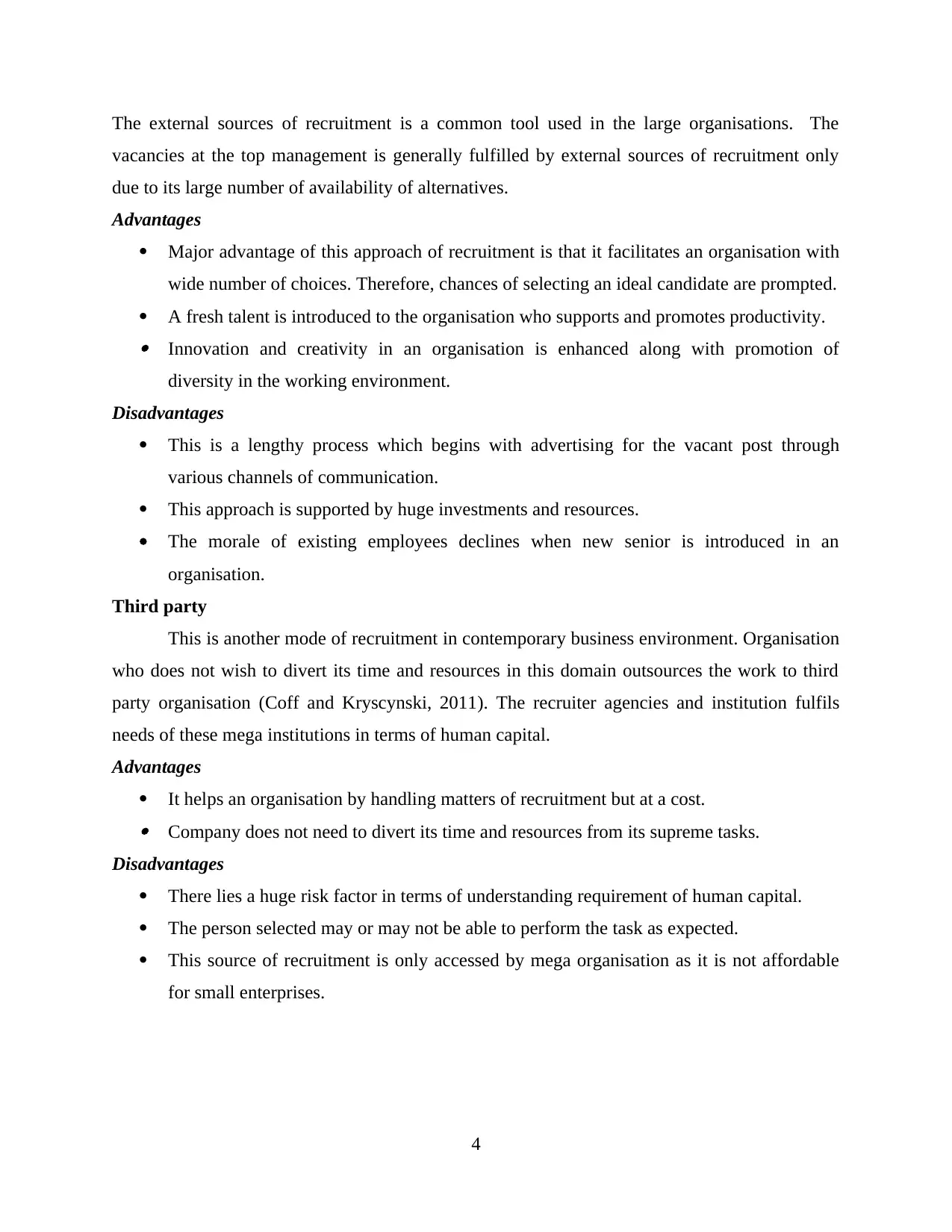
The external sources of recruitment is a common tool used in the large organisations. The
vacancies at the top management is generally fulfilled by external sources of recruitment only
due to its large number of availability of alternatives.
Advantages
Major advantage of this approach of recruitment is that it facilitates an organisation with
wide number of choices. Therefore, chances of selecting an ideal candidate are prompted.
A fresh talent is introduced to the organisation who supports and promotes productivity. Innovation and creativity in an organisation is enhanced along with promotion of
diversity in the working environment.
Disadvantages
This is a lengthy process which begins with advertising for the vacant post through
various channels of communication.
This approach is supported by huge investments and resources.
The morale of existing employees declines when new senior is introduced in an
organisation.
Third party
This is another mode of recruitment in contemporary business environment. Organisation
who does not wish to divert its time and resources in this domain outsources the work to third
party organisation (Coff and Kryscynski, 2011). The recruiter agencies and institution fulfils
needs of these mega institutions in terms of human capital.
Advantages
It helps an organisation by handling matters of recruitment but at a cost. Company does not need to divert its time and resources from its supreme tasks.
Disadvantages
There lies a huge risk factor in terms of understanding requirement of human capital.
The person selected may or may not be able to perform the task as expected.
This source of recruitment is only accessed by mega organisation as it is not affordable
for small enterprises.
4
vacancies at the top management is generally fulfilled by external sources of recruitment only
due to its large number of availability of alternatives.
Advantages
Major advantage of this approach of recruitment is that it facilitates an organisation with
wide number of choices. Therefore, chances of selecting an ideal candidate are prompted.
A fresh talent is introduced to the organisation who supports and promotes productivity. Innovation and creativity in an organisation is enhanced along with promotion of
diversity in the working environment.
Disadvantages
This is a lengthy process which begins with advertising for the vacant post through
various channels of communication.
This approach is supported by huge investments and resources.
The morale of existing employees declines when new senior is introduced in an
organisation.
Third party
This is another mode of recruitment in contemporary business environment. Organisation
who does not wish to divert its time and resources in this domain outsources the work to third
party organisation (Coff and Kryscynski, 2011). The recruiter agencies and institution fulfils
needs of these mega institutions in terms of human capital.
Advantages
It helps an organisation by handling matters of recruitment but at a cost. Company does not need to divert its time and resources from its supreme tasks.
Disadvantages
There lies a huge risk factor in terms of understanding requirement of human capital.
The person selected may or may not be able to perform the task as expected.
This source of recruitment is only accessed by mega organisation as it is not affordable
for small enterprises.
4
Paraphrase This Document
Need a fresh take? Get an instant paraphrase of this document with our AI Paraphraser
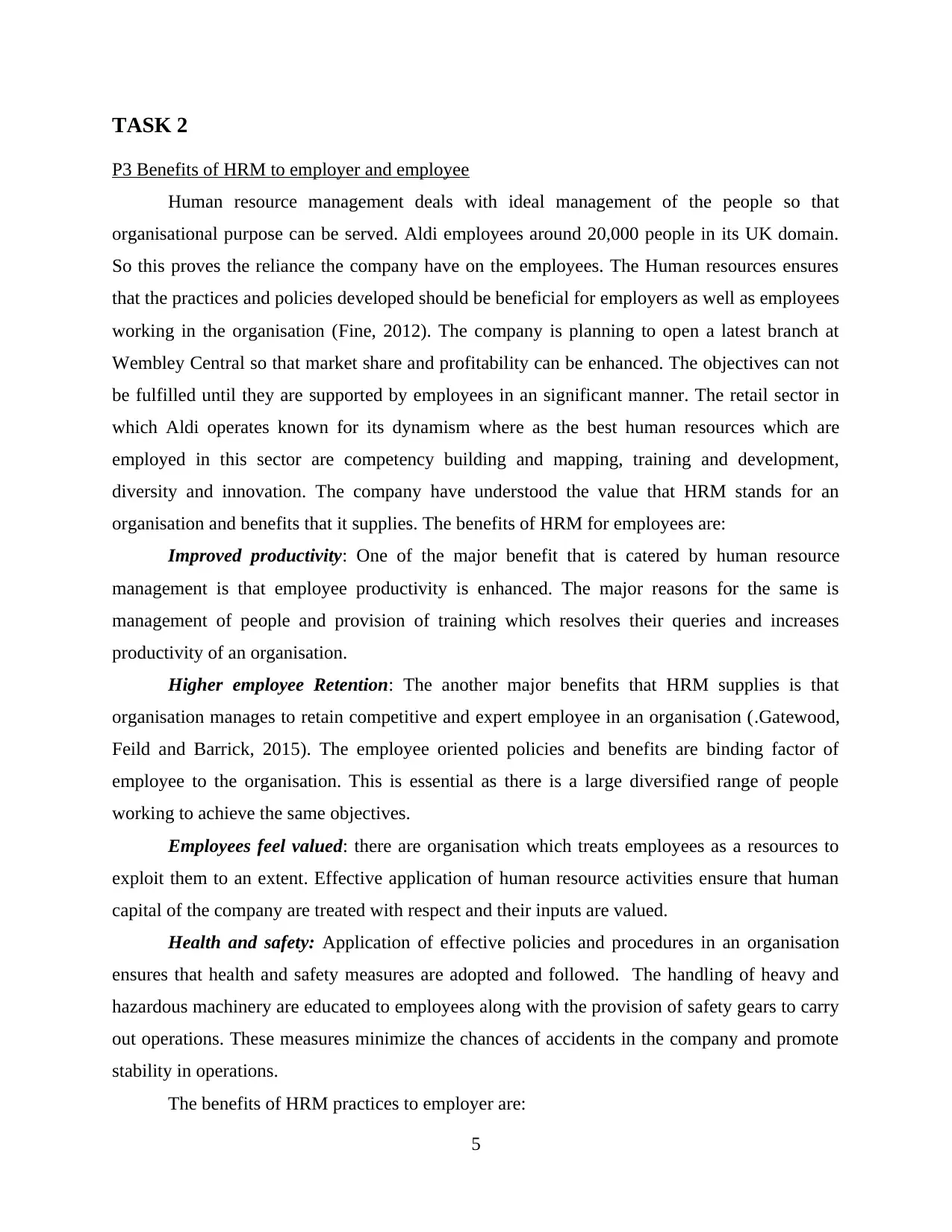
TASK 2
P3 Benefits of HRM to employer and employee
Human resource management deals with ideal management of the people so that
organisational purpose can be served. Aldi employees around 20,000 people in its UK domain.
So this proves the reliance the company have on the employees. The Human resources ensures
that the practices and policies developed should be beneficial for employers as well as employees
working in the organisation (Fine, 2012). The company is planning to open a latest branch at
Wembley Central so that market share and profitability can be enhanced. The objectives can not
be fulfilled until they are supported by employees in an significant manner. The retail sector in
which Aldi operates known for its dynamism where as the best human resources which are
employed in this sector are competency building and mapping, training and development,
diversity and innovation. The company have understood the value that HRM stands for an
organisation and benefits that it supplies. The benefits of HRM for employees are:
Improved productivity: One of the major benefit that is catered by human resource
management is that employee productivity is enhanced. The major reasons for the same is
management of people and provision of training which resolves their queries and increases
productivity of an organisation.
Higher employee Retention: The another major benefits that HRM supplies is that
organisation manages to retain competitive and expert employee in an organisation (.Gatewood,
Feild and Barrick, 2015). The employee oriented policies and benefits are binding factor of
employee to the organisation. This is essential as there is a large diversified range of people
working to achieve the same objectives.
Employees feel valued: there are organisation which treats employees as a resources to
exploit them to an extent. Effective application of human resource activities ensure that human
capital of the company are treated with respect and their inputs are valued.
Health and safety: Application of effective policies and procedures in an organisation
ensures that health and safety measures are adopted and followed. The handling of heavy and
hazardous machinery are educated to employees along with the provision of safety gears to carry
out operations. These measures minimize the chances of accidents in the company and promote
stability in operations.
The benefits of HRM practices to employer are:
5
P3 Benefits of HRM to employer and employee
Human resource management deals with ideal management of the people so that
organisational purpose can be served. Aldi employees around 20,000 people in its UK domain.
So this proves the reliance the company have on the employees. The Human resources ensures
that the practices and policies developed should be beneficial for employers as well as employees
working in the organisation (Fine, 2012). The company is planning to open a latest branch at
Wembley Central so that market share and profitability can be enhanced. The objectives can not
be fulfilled until they are supported by employees in an significant manner. The retail sector in
which Aldi operates known for its dynamism where as the best human resources which are
employed in this sector are competency building and mapping, training and development,
diversity and innovation. The company have understood the value that HRM stands for an
organisation and benefits that it supplies. The benefits of HRM for employees are:
Improved productivity: One of the major benefit that is catered by human resource
management is that employee productivity is enhanced. The major reasons for the same is
management of people and provision of training which resolves their queries and increases
productivity of an organisation.
Higher employee Retention: The another major benefits that HRM supplies is that
organisation manages to retain competitive and expert employee in an organisation (.Gatewood,
Feild and Barrick, 2015). The employee oriented policies and benefits are binding factor of
employee to the organisation. This is essential as there is a large diversified range of people
working to achieve the same objectives.
Employees feel valued: there are organisation which treats employees as a resources to
exploit them to an extent. Effective application of human resource activities ensure that human
capital of the company are treated with respect and their inputs are valued.
Health and safety: Application of effective policies and procedures in an organisation
ensures that health and safety measures are adopted and followed. The handling of heavy and
hazardous machinery are educated to employees along with the provision of safety gears to carry
out operations. These measures minimize the chances of accidents in the company and promote
stability in operations.
The benefits of HRM practices to employer are:
5

Productivity: Productivity can be considered beneficial to both organisation and
employees. The training and development programs provided to employees carries a cumulative
effect on the overall productivity on the organisational as well. The results post training are
better than before and there is less wastages of resources while carrying out of operations.
Competitive Edge: The training and development programs provided to employees
ensures that human capital evolved to such an extent that employee act as a competitive edge to
an organisation over its rivals (Gruman and Saks, 2011). It is the one feature that is difficult to
imitate by competitors of the company.
Organisational culture: An culture of an organisation cover the heterogeneous values,
beliefs and traditions of diversified population. HR Dept. through its tools and techniques wishes
to influence the environment of the company in a positive aspect. Employees in an organisation
should be aware of acceptable practices and procedures which can be carried out so that there is
ideal working culture in the company.
Conflict management: The situation of conflict is nothing new to an organisation. Such
situations arise on a timely basis. With the help of policies and measures company can resolve
such issues which can disrupt functioning of a business in a speedy manner.
Brand Value: the company brand value can be easily enhance with adaptation of right set
of practices and policies. The company's employee centric policies will catch the public eye and
can work as positive word of mouth. The concern shown by organisation towards its employees
will promote positive brand image of the company.
P4 Effectiveness of various HRM practices
There are a variety of practices which are covered by Human resource management. The
need of these practices have increased as the level of competition in the market have increased as
well (Jackson and Parry, 2011). Schuler and Jackson defines “human resource management as
activities aimed to attract, develop, motivate and retain employees in an organisation”. The
various policies and practices are constructed to make sure that efforts of the employee
contribute to the goals established by an institution. The practices are aimed at various aspects
such as competency building, training, promoting employee relations in an organisation.
The application of these policies and practices have resulted in raising profit and
productivity of ALDI. Some of the major practices which fulfil the same are:
6
employees. The training and development programs provided to employees carries a cumulative
effect on the overall productivity on the organisational as well. The results post training are
better than before and there is less wastages of resources while carrying out of operations.
Competitive Edge: The training and development programs provided to employees
ensures that human capital evolved to such an extent that employee act as a competitive edge to
an organisation over its rivals (Gruman and Saks, 2011). It is the one feature that is difficult to
imitate by competitors of the company.
Organisational culture: An culture of an organisation cover the heterogeneous values,
beliefs and traditions of diversified population. HR Dept. through its tools and techniques wishes
to influence the environment of the company in a positive aspect. Employees in an organisation
should be aware of acceptable practices and procedures which can be carried out so that there is
ideal working culture in the company.
Conflict management: The situation of conflict is nothing new to an organisation. Such
situations arise on a timely basis. With the help of policies and measures company can resolve
such issues which can disrupt functioning of a business in a speedy manner.
Brand Value: the company brand value can be easily enhance with adaptation of right set
of practices and policies. The company's employee centric policies will catch the public eye and
can work as positive word of mouth. The concern shown by organisation towards its employees
will promote positive brand image of the company.
P4 Effectiveness of various HRM practices
There are a variety of practices which are covered by Human resource management. The
need of these practices have increased as the level of competition in the market have increased as
well (Jackson and Parry, 2011). Schuler and Jackson defines “human resource management as
activities aimed to attract, develop, motivate and retain employees in an organisation”. The
various policies and practices are constructed to make sure that efforts of the employee
contribute to the goals established by an institution. The practices are aimed at various aspects
such as competency building, training, promoting employee relations in an organisation.
The application of these policies and practices have resulted in raising profit and
productivity of ALDI. Some of the major practices which fulfil the same are:
6
⊘ This is a preview!⊘
Do you want full access?
Subscribe today to unlock all pages.

Trusted by 1+ million students worldwide

Competent employee: The effectiveness of these practices can be evaluated through
competence of employees. The application of HRM practices promote innovation and creativity
in an organisation. The competent employees have a direct contribution to the productivity and
profitability of business as there is a decline in wastages of resources therefore enhancing the
efficiency in operations.
Direction setting: The another major results which can be experienced by application of
HRM practices that it equips organisation with a direction in which they have to execute their
operations. Managers in the organisation along with their tools and techniques can set the
direction and goals for the employees which are to be achieved (Kinicki and et. al., 2014). ALDI
should focus on hiring competent people who possess the capabilities of a leader and eventually
able to lead the people towards the targets.
Updating employee's skills: The HRM practices include training and development of
employees of the organisation. The human resource manager should promote and enhance such
programs in the organisation. Resolution of queries and problems regarding working will result
in improved motivation and productivity of employees.
Collaboration: Collaboration is situation of alliance in the organisation. It is one
important aspect in the organisation which promotes synergy. The association of diversified
members in an organisation gives rise to ideas which manifests latest approaches of carrying out
a task. This feature carries a direct relation with the productivity and profitability of the company
by focusing on new methods of completing task assigned.
Rewards: It is one of the crucial factor which help in motivating an employee to perform
better. ALDI have always have formulated rewards in such a manner that it tempts the
employees to perform up to their potential. Monetary rewards can be directly linked to the
productivity of employees for an establishment (Oechsler, 2011). Non monetary rewards are
equally important in respect to an institution. The types of non-monetary rewards are
appreciation, recognition, exposure and feedback. They contribute to accomplishment of
organisational objectives.
7
competence of employees. The application of HRM practices promote innovation and creativity
in an organisation. The competent employees have a direct contribution to the productivity and
profitability of business as there is a decline in wastages of resources therefore enhancing the
efficiency in operations.
Direction setting: The another major results which can be experienced by application of
HRM practices that it equips organisation with a direction in which they have to execute their
operations. Managers in the organisation along with their tools and techniques can set the
direction and goals for the employees which are to be achieved (Kinicki and et. al., 2014). ALDI
should focus on hiring competent people who possess the capabilities of a leader and eventually
able to lead the people towards the targets.
Updating employee's skills: The HRM practices include training and development of
employees of the organisation. The human resource manager should promote and enhance such
programs in the organisation. Resolution of queries and problems regarding working will result
in improved motivation and productivity of employees.
Collaboration: Collaboration is situation of alliance in the organisation. It is one
important aspect in the organisation which promotes synergy. The association of diversified
members in an organisation gives rise to ideas which manifests latest approaches of carrying out
a task. This feature carries a direct relation with the productivity and profitability of the company
by focusing on new methods of completing task assigned.
Rewards: It is one of the crucial factor which help in motivating an employee to perform
better. ALDI have always have formulated rewards in such a manner that it tempts the
employees to perform up to their potential. Monetary rewards can be directly linked to the
productivity of employees for an establishment (Oechsler, 2011). Non monetary rewards are
equally important in respect to an institution. The types of non-monetary rewards are
appreciation, recognition, exposure and feedback. They contribute to accomplishment of
organisational objectives.
7
Paraphrase This Document
Need a fresh take? Get an instant paraphrase of this document with our AI Paraphraser
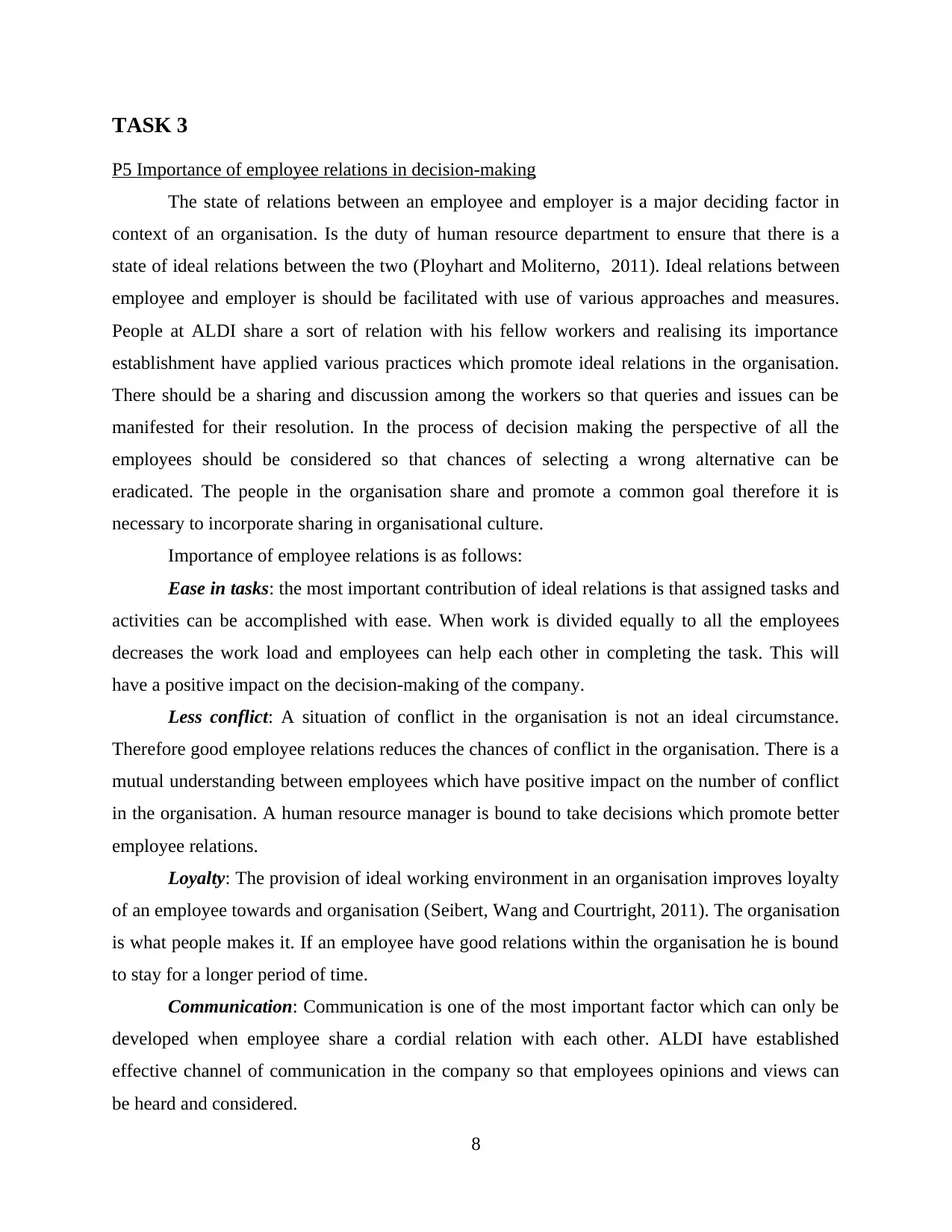
TASK 3
P5 Importance of employee relations in decision-making
The state of relations between an employee and employer is a major deciding factor in
context of an organisation. Is the duty of human resource department to ensure that there is a
state of ideal relations between the two (Ployhart and Moliterno, 2011). Ideal relations between
employee and employer is should be facilitated with use of various approaches and measures.
People at ALDI share a sort of relation with his fellow workers and realising its importance
establishment have applied various practices which promote ideal relations in the organisation.
There should be a sharing and discussion among the workers so that queries and issues can be
manifested for their resolution. In the process of decision making the perspective of all the
employees should be considered so that chances of selecting a wrong alternative can be
eradicated. The people in the organisation share and promote a common goal therefore it is
necessary to incorporate sharing in organisational culture.
Importance of employee relations is as follows:
Ease in tasks: the most important contribution of ideal relations is that assigned tasks and
activities can be accomplished with ease. When work is divided equally to all the employees
decreases the work load and employees can help each other in completing the task. This will
have a positive impact on the decision-making of the company.
Less conflict: A situation of conflict in the organisation is not an ideal circumstance.
Therefore good employee relations reduces the chances of conflict in the organisation. There is a
mutual understanding between employees which have positive impact on the number of conflict
in the organisation. A human resource manager is bound to take decisions which promote better
employee relations.
Loyalty: The provision of ideal working environment in an organisation improves loyalty
of an employee towards and organisation (Seibert, Wang and Courtright, 2011). The organisation
is what people makes it. If an employee have good relations within the organisation he is bound
to stay for a longer period of time.
Communication: Communication is one of the most important factor which can only be
developed when employee share a cordial relation with each other. ALDI have established
effective channel of communication in the company so that employees opinions and views can
be heard and considered.
8
P5 Importance of employee relations in decision-making
The state of relations between an employee and employer is a major deciding factor in
context of an organisation. Is the duty of human resource department to ensure that there is a
state of ideal relations between the two (Ployhart and Moliterno, 2011). Ideal relations between
employee and employer is should be facilitated with use of various approaches and measures.
People at ALDI share a sort of relation with his fellow workers and realising its importance
establishment have applied various practices which promote ideal relations in the organisation.
There should be a sharing and discussion among the workers so that queries and issues can be
manifested for their resolution. In the process of decision making the perspective of all the
employees should be considered so that chances of selecting a wrong alternative can be
eradicated. The people in the organisation share and promote a common goal therefore it is
necessary to incorporate sharing in organisational culture.
Importance of employee relations is as follows:
Ease in tasks: the most important contribution of ideal relations is that assigned tasks and
activities can be accomplished with ease. When work is divided equally to all the employees
decreases the work load and employees can help each other in completing the task. This will
have a positive impact on the decision-making of the company.
Less conflict: A situation of conflict in the organisation is not an ideal circumstance.
Therefore good employee relations reduces the chances of conflict in the organisation. There is a
mutual understanding between employees which have positive impact on the number of conflict
in the organisation. A human resource manager is bound to take decisions which promote better
employee relations.
Loyalty: The provision of ideal working environment in an organisation improves loyalty
of an employee towards and organisation (Seibert, Wang and Courtright, 2011). The organisation
is what people makes it. If an employee have good relations within the organisation he is bound
to stay for a longer period of time.
Communication: Communication is one of the most important factor which can only be
developed when employee share a cordial relation with each other. ALDI have established
effective channel of communication in the company so that employees opinions and views can
be heard and considered.
8
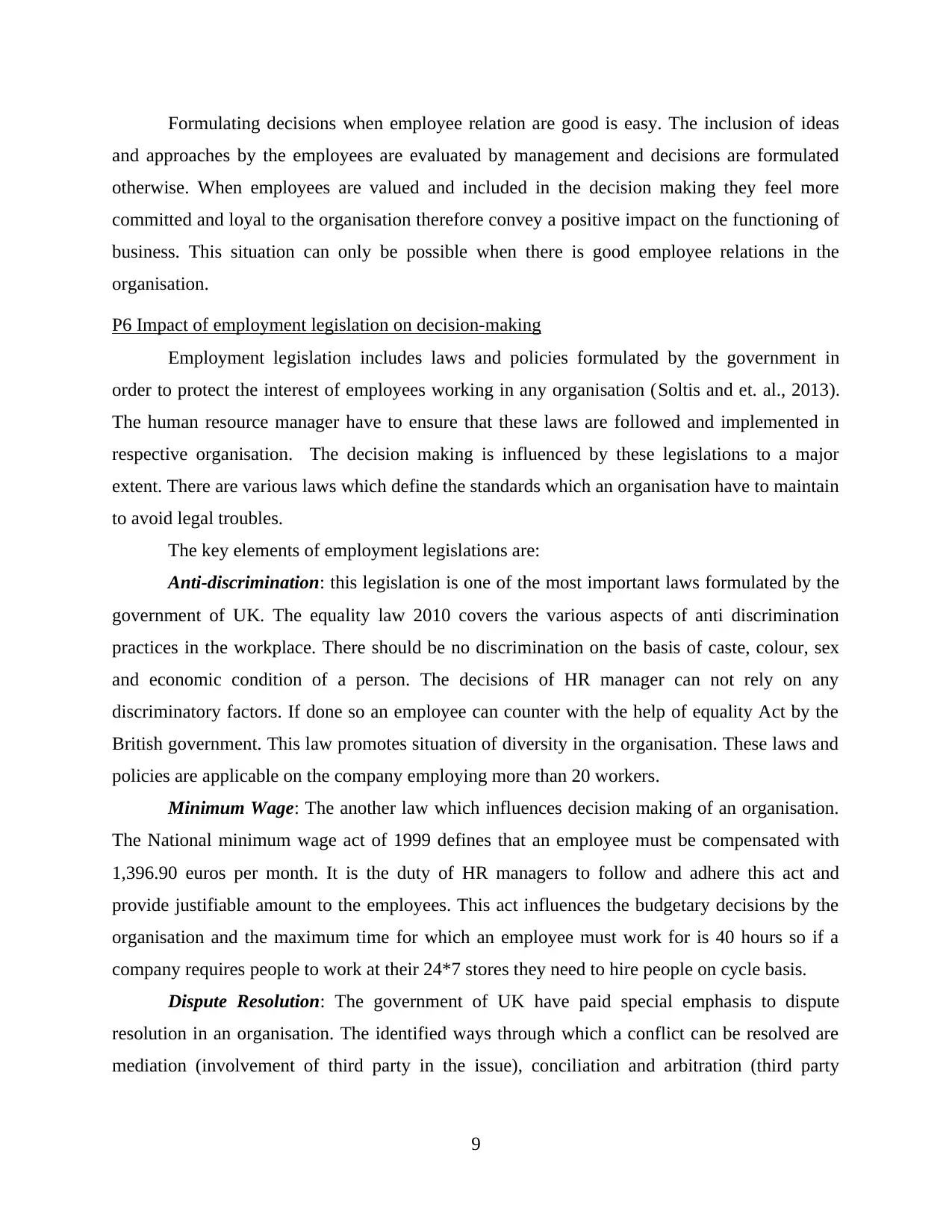
Formulating decisions when employee relation are good is easy. The inclusion of ideas
and approaches by the employees are evaluated by management and decisions are formulated
otherwise. When employees are valued and included in the decision making they feel more
committed and loyal to the organisation therefore convey a positive impact on the functioning of
business. This situation can only be possible when there is good employee relations in the
organisation.
P6 Impact of employment legislation on decision-making
Employment legislation includes laws and policies formulated by the government in
order to protect the interest of employees working in any organisation (Soltis and et. al., 2013).
The human resource manager have to ensure that these laws are followed and implemented in
respective organisation. The decision making is influenced by these legislations to a major
extent. There are various laws which define the standards which an organisation have to maintain
to avoid legal troubles.
The key elements of employment legislations are:
Anti-discrimination: this legislation is one of the most important laws formulated by the
government of UK. The equality law 2010 covers the various aspects of anti discrimination
practices in the workplace. There should be no discrimination on the basis of caste, colour, sex
and economic condition of a person. The decisions of HR manager can not rely on any
discriminatory factors. If done so an employee can counter with the help of equality Act by the
British government. This law promotes situation of diversity in the organisation. These laws and
policies are applicable on the company employing more than 20 workers.
Minimum Wage: The another law which influences decision making of an organisation.
The National minimum wage act of 1999 defines that an employee must be compensated with
1,396.90 euros per month. It is the duty of HR managers to follow and adhere this act and
provide justifiable amount to the employees. This act influences the budgetary decisions by the
organisation and the maximum time for which an employee must work for is 40 hours so if a
company requires people to work at their 24*7 stores they need to hire people on cycle basis.
Dispute Resolution: The government of UK have paid special emphasis to dispute
resolution in an organisation. The identified ways through which a conflict can be resolved are
mediation (involvement of third party in the issue), conciliation and arbitration (third party
9
and approaches by the employees are evaluated by management and decisions are formulated
otherwise. When employees are valued and included in the decision making they feel more
committed and loyal to the organisation therefore convey a positive impact on the functioning of
business. This situation can only be possible when there is good employee relations in the
organisation.
P6 Impact of employment legislation on decision-making
Employment legislation includes laws and policies formulated by the government in
order to protect the interest of employees working in any organisation (Soltis and et. al., 2013).
The human resource manager have to ensure that these laws are followed and implemented in
respective organisation. The decision making is influenced by these legislations to a major
extent. There are various laws which define the standards which an organisation have to maintain
to avoid legal troubles.
The key elements of employment legislations are:
Anti-discrimination: this legislation is one of the most important laws formulated by the
government of UK. The equality law 2010 covers the various aspects of anti discrimination
practices in the workplace. There should be no discrimination on the basis of caste, colour, sex
and economic condition of a person. The decisions of HR manager can not rely on any
discriminatory factors. If done so an employee can counter with the help of equality Act by the
British government. This law promotes situation of diversity in the organisation. These laws and
policies are applicable on the company employing more than 20 workers.
Minimum Wage: The another law which influences decision making of an organisation.
The National minimum wage act of 1999 defines that an employee must be compensated with
1,396.90 euros per month. It is the duty of HR managers to follow and adhere this act and
provide justifiable amount to the employees. This act influences the budgetary decisions by the
organisation and the maximum time for which an employee must work for is 40 hours so if a
company requires people to work at their 24*7 stores they need to hire people on cycle basis.
Dispute Resolution: The government of UK have paid special emphasis to dispute
resolution in an organisation. The identified ways through which a conflict can be resolved are
mediation (involvement of third party in the issue), conciliation and arbitration (third party
9
⊘ This is a preview!⊘
Do you want full access?
Subscribe today to unlock all pages.

Trusted by 1+ million students worldwide
1 out of 17
Related Documents
Your All-in-One AI-Powered Toolkit for Academic Success.
+13062052269
info@desklib.com
Available 24*7 on WhatsApp / Email
![[object Object]](/_next/static/media/star-bottom.7253800d.svg)
Unlock your academic potential
Copyright © 2020–2025 A2Z Services. All Rights Reserved. Developed and managed by ZUCOL.





